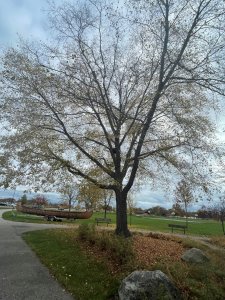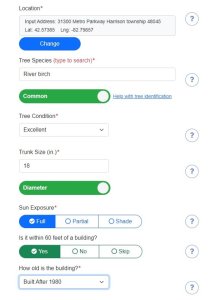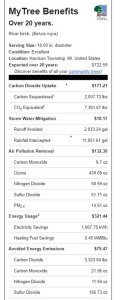Climate Action in the Classroom: The Value of Trees
November 8, 2023
By Erin Parker, Interpretive Services Supervisor
Do you have a favorite tree? Maybe it grew in your childhood backyard, tall and strong and holding a tire swing that kept you busy during the seemingly-endless summers of youth. Maybe your favorite tree is the ancient, gnarled type that marks a mountain summit. Or maybe it shades a fishing hole or other beloved spot. Trees provide food, shelter, habitat, a variety of wood and paper products, and, at least for humans, evocative memories of places and experiences.
 Trees also conduct a variety of ecosystem services which are all the many benefits provided by the environment. Trees absorb stormwater, filter air pollution, create shade, buffer wind, and store carbon dioxide. Have you ever considered the specific services provided by a tree?
Trees also conduct a variety of ecosystem services which are all the many benefits provided by the environment. Trees absorb stormwater, filter air pollution, create shade, buffer wind, and store carbon dioxide. Have you ever considered the specific services provided by a tree?
i-Tree
There are some amazing (and free!) tools to use to start determining the value that an individual tree provides. I-Tree, found at itreetools.org, is a great place to start.
Let’s determine the values of the Yellow Birch (Betula Alleghaniensis) that grows outside the front entrance of Lake St Clair Metropark Nature Center. The nature center staff already recognizes that it provides year-round food and shelter to a variety of birds, insects, and small mammals because we see and hear a lot of the tree’s visitors throughout the year. And, being planted so close to the building, it helps provide shade in the summer and a windbreak through the seasons. But what other, less noticeable services does our tree provide?
Measuring our tree
First, I took a tape measure outside to the tree and found the point about 3.5 feet from the ground that marks “diameter at breast height” or DBH, a common forestry measurement intended to keep tree comparison consistent. Our birch has three trunks, so I selected the main trunk, which is larger than the other two, and used that for my measurements.
Now, I can input my measurements and find out what my tree is doing out there! After opening itreetools.org, I selected MyTree and entered my information:


Here’s what we learned about the yellow birch outside the nature center, based on the location, size, and current health estimates of the tree.
This single tree will sequester more than 7000 pounds of carbon dioxide, reduce more than
2,000 gallons of stormwater runoff, pull a variety of noxious gases from the air, and even reduce our electricity expenditures by shading and cooling our building in the summer months.
I-Tree also helps you examine the value of a whole forest of trees, compare tree cover and value in different parts of the country, and consider what tree or trees might benefit the planter the most through time.
